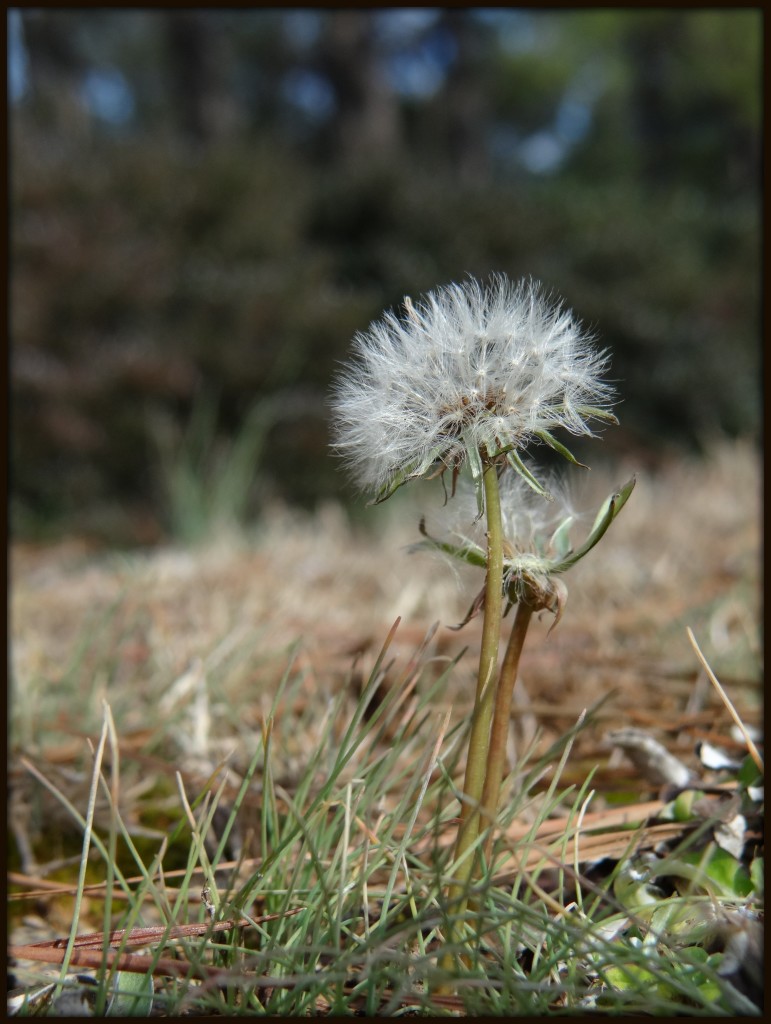And after the vibrant yellow bloom has passed, and the feathery seeds have all dispersed, after all that, there is sa certain beauty to the form of a dandelion stalk still standing along the roadside.

And after the vibrant yellow bloom has passed, and the feathery seeds have all dispersed, after all that, there is sa certain beauty to the form of a dandelion stalk still standing along the roadside.

On a cloudy, balmy afternoon in late February, I walked Piney Woods Church Road in search of sunlight. The skies remained gray, but along the roadside I found a dandelion sun.

 There is perhaps no more commonly recognized reminder of spring in a Georgia backyard than the appearance of the first dandelion bloom. For some, the first common dandelion (Taraxacum officinale) is a bright yellow promise of warm days to come and wildflowers soon to bloom. For others, it marks the beginning of another round of the battle between human and weed, waged on lawns across the country.
There is perhaps no more commonly recognized reminder of spring in a Georgia backyard than the appearance of the first dandelion bloom. For some, the first common dandelion (Taraxacum officinale) is a bright yellow promise of warm days to come and wildflowers soon to bloom. For others, it marks the beginning of another round of the battle between human and weed, waged on lawns across the country.
In its commonness, it is a plant easily ignored by adults. Children know better. They pluck bouquets of dandelions to give to parents and friends, not minding temporary skin discoloration from the sticky, milky sap in the flowers’ hollow stems. Even more enthusiastically, they pluck up the seed heads, blowing them apart and helping to disperse the seeds to a neighbor’s picture-perfect weed-free yard. This writer recalls doing these things, and especially watching the seed heads parachuting away on a spring breeze, to parts unknown.
In its commonness, it is a reminder of how little we know about, and appreciate, mundane nature — the myriad living things all around us that we take for granted as the years go by. The dandelion is worth a second look. There is more going on than meets the eye at a single glance. Take, for example, the leaves of a dandelion. They form a basal rosette, a swirl of leaves close to the ground. Each leaf has a central vein with a groove down the center, and when it rains, this groove channels the rainfall directly to the center of the plant. Besides appreciating the leaves for their structure, one can also appreciate their edibility. They make a tasty addition to salads, while being higher in Vitamin A than carrots, and also containing large amounts of Vitamin C, potassium, iron, and calcium.
The dandelion also possesses an impressive taproot, reaching into the ground a foot or more. In some plants, the taproot may constitute as much as half of the plant by mass. Roasted, the root provides a coffee-substitute with a number of purported health benefits. The root also offers an excellent upper-arm workout for weeders.
Finally, there is the dandelion bloom itself, with its complex life-cycle. The flower head contains up to 200 tiny overlapping flowers. Their pollen attracts hungry ladybugs, serving to reduce the number of aphids that would otherwise feed on garden plants. The flowerheads open at about nine in the morning, and close again in the afternoon, lasting only about a day. Then they seal tight for a couple of days, undergoing a botanical metamorphosis, like a caterpillar in a chrysalis. During this time, the stalk elongates, lifting the flower higher into the air. Finally the head opens again, revealing a “fairy clock”, a globe of barbed seeds with downy parachutes. In time, those seeds are carried away in the wind, or rising convection currents, or the gentle breath of a child.
This article was originally published on March 28, 2010.
A few days ago, I began adding to my Piney Woods Church Road walk a few furtive glances for signs of spring. I have been watching, in particular, for daffodils to emerge from the soil — there are quite a few clusters of them growing in and alongside a pasture about halfway on my walk. Alas, no luck yet. Imagine my surprise today when I discovered a dandelion — not a budding flower stalk, or even an open flower, but a seed head, waiting for the wind. It is a marvelous reminder of all that I have missed this year. Somehow, the flower stalk emerged and bloomed and produced seeds during January and early February, all without my noticing. But today I paused to take this photograph. After snapping half a dozen shots, as I was about to stop and be on my way home, the sun emerged from a cloud. A lovely moment on a Saturday afternoon in not-yet-springtime.
